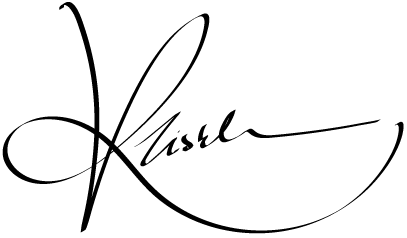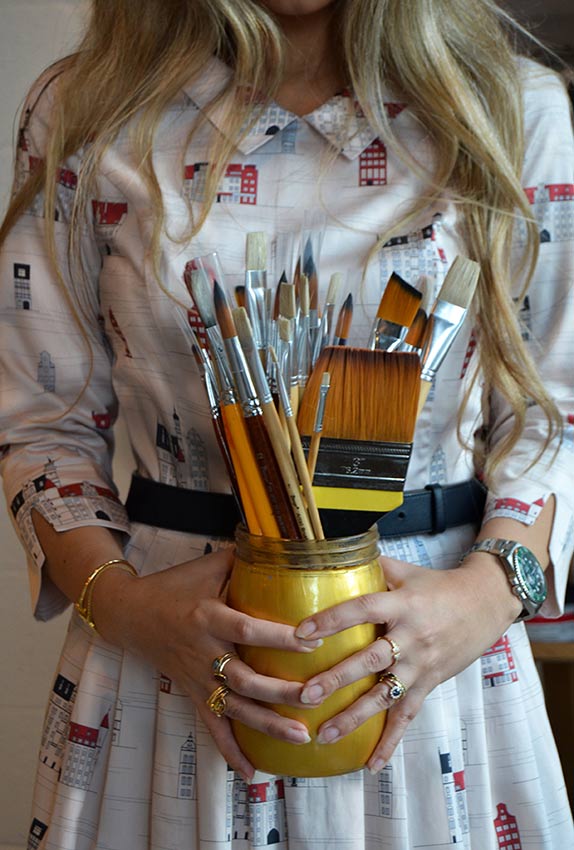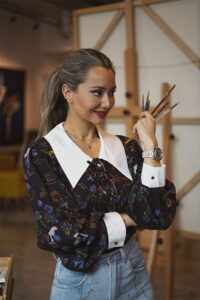As the calendar flips to another year, creative individuals around the world find themselves at a familiar crossroads. It’s that time when we reflect on our creative journey, celebrate our accomplishments, and set our sights on new horizons. Setting creative goals for 2024 isn’t just a routine; it’s a powerful act of envisioning and shaping your artistic future.
As a visual artist who thrives on weaving stories through expressive colors and bold patterns on a monochromatic backdrop, I understand the intricate dance of creativity and ambition. In this blog, we’ll embark on a journey of discovery and motivation, exploring the art of setting artistic goals for 2024 and why it’s vital for your artistic growth.
Original goals are the compass that guides us through the vast landscape of artistic expression. They serve as a roadmap, helping us navigate our way to new realms of creativity and achievement. While the artistic process is often driven by inspiration and passion, goals provide structure and purpose.
Setting inventive goals forces you to clarify your artistic vision. It encourages you to define what you want to achieve in your art, whether it’s mastering a new technique, completing a series of artworks, or venturing into uncharted creative territory.
For me, as an artist who seeks to depict life’s polarities and provoke contemplation through my work, setting goals means deciding how I’ll explore these themes further. It might involve experimenting with different mediums, expanding my portfolio, or even delving into collaborations that align with my artistic vision.
Artistic fears, like self-doubt and fear of failure, often lurk in the shadows of our creative minds. Setting goals allows us to confront and conquer these fears. When you outline what you want to achieve, you’re essentially telling those nagging doubts that you’re committed to your artistic journey.
Every creative individual has faced moments of uncertainty. As a visual artist, I’ve encountered times when I questioned the direction of my art or whether my work would resonate with others. However, by setting specific goals, I’ve learned to turn these moments into opportunities for growth. Instead of succumbing to fear, I focus on the steps I need to take to reach my goals.
The creative landscape is constantly evolving, with technology playing an increasingly prominent role. Embracing new tools and technologies can be a creative goal in itself. Whether it’s incorporating digital art techniques or exploring innovative ways to present your work, creative technology can open new inventive horizons.
For me, incorporating technology means exploring digital art’s vast possibilities while staying true to my signature style of using expressive colors and bold patterns. It’s a balance between traditional and digital, a fusion that enhances the storytelling aspect of my art.
Business for creatives is an aspiration to many artists who aspire to turn their passion into a viable business. Setting goals that bridge the gap between artistry and entrepreneurship is essential. It involves understanding the business side of your craft, from marketing and sales to building a brand that resonates with your audience.
In today’s interconnected world, artists have unprecedented opportunities to share their work and engage with art lovers globally. Goals related to the business side of art can help you leverage these opportunities effectively.
The artist mindset is a blend of creativity, resilience, and an unyielding commitment to one’s craft. Setting goals that nurture this mindset is about continuous self-improvement. It involves seeking inspiration, learning from both successes and setbacks, and never settling for mediocrity.
In my own artistic journey, maintaining the artist approach means staying open to inspiration from various sources, whether it’s nature, culture, or daily life. It means embracing challenges as opportunities to grow and evolve as an artist.
Now that we’ve explored why goals are essential, let’s delve into the art of objective setting itself. Effective goal setting is more than jotting down a list of aspirations; it’s a thoughtful and strategic process.
Start by defining your original goals with clarity and specificity. What do you want to achieve in your art in 2024? Whether it’s creating a body of work that explores a particular theme, participating in a significant art exhibition, or reaching a specific audience milestone, your goals should be precise.
For me, a defined goal might involve creating a series of artworks that delve into the concept of unity in diversity. I would outline the number of pieces, the mediums I intend to use, and the themes I want to explore within this series.
Large artistic goals can be daunting, so it’s essential to break them down into smaller, manageable tasks. Think of these tasks as stepping stones that lead you to your overarching goal. This approach makes your goals less overwhelming and more achievable.
For instance, if your goal is to hold your first solo art exhibition in 2024, the smaller tasks could include selecting a theme, creating a series of artworks, finding a suitable venue, and marketing the event.
Deadlines are the heartbeat of setting objectives. They infuse your goals with a sense of urgency and accountability and artistic fears set in. Without deadlines, goals can often linger as vague aspirations. Set realistic but challenging deadlines for each of your smaller tasks.
In my case, if I aim to complete a series of ten artworks exploring unity in diversity, I would assign deadlines for the completion of each piece, ensuring I stay on track to meet my exhibition goal.
Regularly monitoring your progress is vital to successful goal achievement. It allows you to assess whether you’re on track, make necessary adjustments, and celebrate milestones along the way.
As a visual artist, I might use a project management tool to track the status of each new artwork in my series. It helps me visualize my progress and identify areas where I need to dedicate more time and effort.
While setting goals is crucial, it’s equally important to remain flexible. Creativity often thrives in unexpected moments and directions. Be open to adjusting your goals if you discover new passions or opportunities that align with your artistic journey.
As we venture into 2024, setting artistic goals is an act of self-discovery and empowerment. It’s about defining your artistic vision, confronting fears, embracing technology, nurturing the artist mind, and translating creativity into a sustainable venture.
For me, these goals represent a map that guides my journey as I continue to tell stories through my art using expressive colors and bold patterns on a monochromatic background. They are the stepping stones that lead me toward my aspirations of exploring life’s polarities and provoking contemplation in the hearts of those who view my work.
As a fellow creative, I encourage you to embark on this journey of setting artistic goals for 2024. Define your vision, break down your goals, set deadlines, monitor your progress, and above all, stay flexible. Remember, it’s not just about reaching the destination; it’s about the growth, fulfillment, and inspiration you encounter along the way. Here’s to a year filled with boundless creativity and artistic achievement!
Shop my artwork collection.
Check my digital artwork collection.


